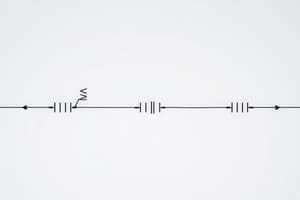Podcast
Questions and Answers
What is the primary reason for the preference of AC voltage over DC voltage?
What is the primary reason for the preference of AC voltage over DC voltage?
AC voltages can be easily and efficiently converted from one voltage to another using transformers.
The terms AC voltage and AC current are considered contradictory and redundant.
The terms AC voltage and AC current are considered contradictory and redundant.
True (A)
What does AC stand for in electrical terms?
What does AC stand for in electrical terms?
- Alternative Current
- Alternating Circuit
- Alternating Current (correct)
- Alternating Charge
What is the equation for the AC voltage applied to a resistor?
What is the equation for the AC voltage applied to a resistor?
Who conceived the idea of the rotating magnetic field?
Who conceived the idea of the rotating magnetic field?
The potential difference in AC voltage can be expressed as ______.
The potential difference in AC voltage can be expressed as ______.
What is the SI unit of magnetic field named after?
What is the SI unit of magnetic field named after?
According to Kirchhoff's loop rule, what is the equation for the current through a resistor in an AC circuit?
According to Kirchhoff's loop rule, what is the equation for the current through a resistor in an AC circuit?
How is the total impedance (Z) in an AC circuit calculated when given resistance (R), inductive reactance (XL), and capacitive reactance (XC)?
How is the total impedance (Z) in an AC circuit calculated when given resistance (R), inductive reactance (XL), and capacitive reactance (XC)?
What is the significance of a negative phase difference, as indicated by the value of -53.1° in an AC circuit?
What is the significance of a negative phase difference, as indicated by the value of -53.1° in an AC circuit?
Using the given values, how would you calculate the power (P) dissipated in an AC circuit with a current (I) of 40A and resistance (R) of 3Ω?
Using the given values, how would you calculate the power (P) dissipated in an AC circuit with a current (I) of 40A and resistance (R) of 3Ω?
What is the formula for calculating capacitive reactance (XC) in an AC circuit, and how is it influenced by frequency (ν)?
What is the formula for calculating capacitive reactance (XC) in an AC circuit, and how is it influenced by frequency (ν)?
Explain the relationship between the power factor and phase angle in an AC circuit.
Explain the relationship between the power factor and phase angle in an AC circuit.
What condition must be met for a transformer to be considered 100% efficient?
What condition must be met for a transformer to be considered 100% efficient?
How does the number of turns in the secondary coil affect the voltage output?
How does the number of turns in the secondary coil affect the voltage output?
What happens to the current when the voltage is stepped up in a transformer?
What happens to the current when the voltage is stepped up in a transformer?
Identify the relationship between voltage and turns for a step-down transformer.
Identify the relationship between voltage and turns for a step-down transformer.
What is the significance of equation (7.35) in the context of a transformer?
What is the significance of equation (7.35) in the context of a transformer?
What are the ideal conditions assumed for deriving the equations related to transformers?
What are the ideal conditions assumed for deriving the equations related to transformers?
Describe the term 'step-up transformer' based on the number of turns in the coils.
Describe the term 'step-up transformer' based on the number of turns in the coils.
How does a transformer's efficiency impact its practical application?
How does a transformer's efficiency impact its practical application?
How does the current through an inductor compare to the voltage in an AC circuit?
How does the current through an inductor compare to the voltage in an AC circuit?
Does an inductor consume power in an AC circuit, and why?
Does an inductor consume power in an AC circuit, and why?
Calculate the inductive reactance of a pure inductor with 25.0 mH at a frequency of 50 Hz.
Calculate the inductive reactance of a pure inductor with 25.0 mH at a frequency of 50 Hz.
What is the rms current in a circuit with a 220 V source connected to a pure inductor with an inductive reactance of 7.85 Ω?
What is the rms current in a circuit with a 220 V source connected to a pure inductor with an inductive reactance of 7.85 Ω?
What happens to current flow in a capacitor when connected to a DC voltage source?
What happens to current flow in a capacitor when connected to a DC voltage source?
In an AC circuit with a capacitor, describe the nature of current flow.
In an AC circuit with a capacitor, describe the nature of current flow.
Define the relationship between instantaneous power in an inductor and the sine function.
Define the relationship between instantaneous power in an inductor and the sine function.
How does the average power over one complete cycle in an inductor relate to energy consumption?
How does the average power over one complete cycle in an inductor relate to energy consumption?
Calculate the capacitive reactance of a 15.0 µF capacitor connected to a 220 V, 50 Hz AC source.
Calculate the capacitive reactance of a 15.0 µF capacitor connected to a 220 V, 50 Hz AC source.
What is the rms current flowing through a circuit with a capacitor having a capacitive reactance of 212 Ω and a voltage of 220 V?
What is the rms current flowing through a circuit with a capacitor having a capacitive reactance of 212 Ω and a voltage of 220 V?
Given the peak current is 1.47 A, how does it relate to the rms current?
Given the peak current is 1.47 A, how does it relate to the rms current?
What happens to the capacitive reactance and the current when the frequency of the AC source is doubled?
What happens to the capacitive reactance and the current when the frequency of the AC source is doubled?
How does inserting an iron rod into the inductor affect the glow of the light bulb in the circuit?
How does inserting an iron rod into the inductor affect the glow of the light bulb in the circuit?
Explain why the inductive reactance increases when the iron rod is introduced into the inductor.
Explain why the inductive reactance increases when the iron rod is introduced into the inductor.
If the initial capacitive reactance is 212 Ω, how can it affect the brightness of the lamp?
If the initial capacitive reactance is 212 Ω, how can it affect the brightness of the lamp?
What is the relationship between the reactance and the current in an AC circuit with reactive components?
What is the relationship between the reactance and the current in an AC circuit with reactive components?
What happens to the current in a circuit when the capacitor is fully charged?
What happens to the current in a circuit when the capacitor is fully charged?
How does a capacitor behave when connected to an AC source?
How does a capacitor behave when connected to an AC source?
What is the relationship between instantaneous voltage (v), charge (q), and capacitance (C) for a capacitor?
What is the relationship between instantaneous voltage (v), charge (q), and capacitance (C) for a capacitor?
Using Kirchhoff’s loop rule, what is the equation relating the voltage across the voltage source and the capacitor?
Using Kirchhoff’s loop rule, what is the equation relating the voltage across the voltage source and the capacitor?
What formula can be used to derive the current (i) in a capacitor driven by an AC supply?
What formula can be used to derive the current (i) in a capacitor driven by an AC supply?
How is the amplitude of the oscillating current (i_m) expressed in terms of angular frequency (ω), capacitance (C), and peak voltage (v_m)?
How is the amplitude of the oscillating current (i_m) expressed in terms of angular frequency (ω), capacitance (C), and peak voltage (v_m)?
What role does the term $\frac{1}{\omega C}$ play when comparing AC circuits to purely resistive circuits?
What role does the term $\frac{1}{\omega C}$ play when comparing AC circuits to purely resistive circuits?
What is the alternative expression for the current i in terms of sine function from the cosine function?
What is the alternative expression for the current i in terms of sine function from the cosine function?
Flashcards are hidden until you start studying
Study Notes
Introduction to Alternating Current (AC)
- Alternating current (AC) is a type of electrical current that changes direction periodically.
- AC is used in homes, offices, and to power most electrical devices.
- AC is preferred over direct current (DC) because it can be transformed easily with transformers.
- Voltage and current in AC circuits vary sinusoidally with time, characterized by amplitude and angular frequency.
- Nikola Tesla is credited with pioneering AC technology, including the rotating magnetic field principle and the Tesla coil.
AC Voltage Applied to a Resistor
- A resistor connected to an AC voltage source experiences a current that varies sinusoidally with time.
- The AC voltage across the resistor is represented by: v = vm sin ω t
- vm is the maximum voltage and ω is the angular frequency.
- Applying Kirchhoff's loop rule to the circuit, we obtain the relationship: vm sin ω t = iR
- The current through the resistor is given by: i = im sin ω t, where im = vm/R and is the maximum current..
Inductor's Behavior in AC Circuits
- Inductor does not consume power, it stores and releases energy in its magnetic field
- Average power supplied to an inductor over a complete cycle is zero
- Inductive reactance (XL) limits the current in a similar way that resistance does in a DC circuit
- In an AC circuit, the current flowing through an inductor lags behind the voltage across it by a phase angle of π/2
- XL is directly proportional to the frequency of the AC source and the inductance of the inductor
### Capacitor's Behavior in AC Circuits
- Capacitor allows current to flow by alternately charging and discharging as the current flow reverses
- Capacitor opposes the current flow in AC circuits, but does not completely block it unlike in DC circuits
- Current in a purely capacitive circuit leads the voltage across it by a phase angle of π/2
- Capacitive reactance (XC) limits the current flow in a similar way that resistance does in a DC circuit
- XC is inversely proportional to the frequency of the AC source and the capacitance of the capacitor
### Transformers
- Transformers are devices that transform AC voltage and current without changing the power
- Power input to a transformer is equal to the power output, assuming no losses
- Transformers work on the principle of electromagnetic induction
- Step-up transformer increases voltage and decreases current when Ns > Np
- Step-down transformer decreases voltage and increases current when Ns < Np
- Transformer efficiency is typically high, often exceeding 95%
Studying That Suits You
Use AI to generate personalized quizzes and flashcards to suit your learning preferences.




